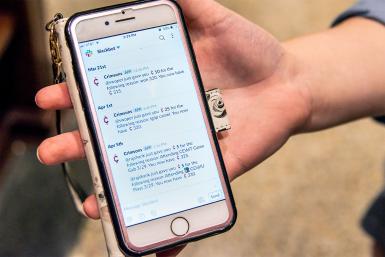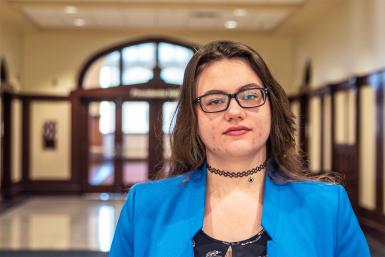Game design program’s virtual currency rewards, ‘re-enchants’

When senior Stephanie Davidson needs a 24-hour extension on an assignment in a game design class, she buys it.
She pays for it with Crimsons, a point-like currency used to reward students in the game design program.
Professors give them out for good work, such as doing well on an assignment or giving a thoughtful answer in class. Students can use them for extensions, absences and even cool game gear auctioned off throughout the year.
By program standards, Davidson is rich. She said she has about 300 Crimsons, which she estimates puts her among “the Crimson one percent.”
Most students only have somewhere between zero and 50 Crimsons, because they earn them from professors just a few at a time, Davidson said. She earned hers by going to events as an officer for what was then Hoosier Games, now Gamedev@IU.
Professor Ted Castronova implemented the currency sometime around 2015, when he was director of the game design program. He wanted to create a system that allowed professors to reward students for good work in a way that wouldn’t be connected to their grades.
Castronova is author of several books about virtual currencies in the game design world — his most recent is “Wildcat Currency: The Virtual Transformation of the Economy” — exploring some of the same theories and themes that he’s put into place with Crimsons.
He wanted it to start with a bit of mystery, so at first he didn’t explain how Crimsons could be earned or why the term was suddenly popping up in students’ Slack workspace.
To him, the quiet implementation was a way to challenge students to talk among each other to figure out how the local currency worked.

“I think it’s a really neat addition to the educational mission of the program,” Castronova said. “You get people talking about more things than they were before.”
Crimsons are different from cryptocurrency such as Bitcoin that can be used like real money. Instead, they are a virtual version of classroom dollars that some teachers might use in elementary school.
Students can “buy” rewards such as absences, 24-hour assignment extensions and items — mostly game merchandise acquired at conferences — auctioned off by professors.
Students can also trade Crimsons among each other in exchange for tutoring or someone’s specialized skill on a game project, although Castronova said this aspect isn’t used as much as he’d like it to be.
Crimsons have been used in weird ways as well.
At least one couple has used them to flirt, sending romantic messages in the subject line of their Slack transactions.
Castronova, who said he gave generous amounts of Crimsons when he first started using them, created a story about a tree nymph named Mabyn who was angry about a blue rope high up in a tree outside Castronova’s office.
He gave a Crimson reward to students who could get the rope out of the tree, and suddenly they were bringing ladders to get the rope down and creating more of the mythology.
“We can re-enchant the things that have been disenchanted,” Castronova said.
Castronova said he wasn’t sure at first what kind of system to create, so he asked adjunct lecturer and coder Chabane Maidi to help him figure out how to make it work.
Maidi kept it simple by creating a code for Slack, a workspace app students and professors were already using. By typing certain commands, professors perform tasks such as giving out Crimsons or checking students’ balances.

The program had to be created from scratch because Maidi couldn’t find any similar creations that had already been invented, Maidi said.
“I don’t know why those things don’t exist,” Maidi said.
Maidi said he originally called his creation TedCoin, but the final name was voted on by students from a shortlist created by the game design faculty.
“It became part of the program very quickly, and now a lot of the program revolves around the trade and distribution of Crimsons,” Maidi said.
With all her Crimsons, Davidson said she participates in auctions and has won a T-shirt and high-quality sleep mask.
However, she said they really come in handy when she’s feeling overwhelmed by deadlines, especially as projects pile up at the end of a semester.
“It’s nice to have that safety,” Davison said.

